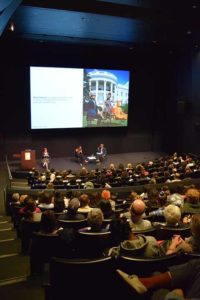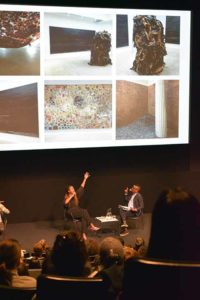Art, Social Media and Inclusion: Black Futures with Kimberly Drew
Laura Belik on the Arts + Design Mondays @ BAMPFA | Public (Re)Assembly talk series
Black Futures: On Race in Art, Curation, and Digital Engagement with Kimberly Drew and Stephen Best, October 16, 2017
 It was hard to find an empty seat that evening in the auditorium. Kimberly Drew was the guest speaker and Berkeley was excited to hear how outspoken she probably would be in person, as she is online. Kimberly Drew represents an important voice for black artists and the arts community. Creator of the Tumblr blog “Black Contemporary Art”, Kimberly Drew gained a lot of space on social media while still in Smith College, where she graduated with a B.A. in Art History and Africana Studies, and a concentration in Museum Studies. Her visibility since then led her to be invited to work with several institutions, as well as to be considered a great advocate and spokesperson for racial equality in the U.S.
It was hard to find an empty seat that evening in the auditorium. Kimberly Drew was the guest speaker and Berkeley was excited to hear how outspoken she probably would be in person, as she is online. Kimberly Drew represents an important voice for black artists and the arts community. Creator of the Tumblr blog “Black Contemporary Art”, Kimberly Drew gained a lot of space on social media while still in Smith College, where she graduated with a B.A. in Art History and Africana Studies, and a concentration in Museum Studies. Her visibility since then led her to be invited to work with several institutions, as well as to be considered a great advocate and spokesperson for racial equality in the U.S.
Kimberly Drew started on social media at first for herself. She recalls getting to know more about the works of artists such as Jean-Michel Basquiat while interning at the Studio Museum of Harlem and thinking about how much they had changed her life, and how many people don’t have access to this kind of information. Thus, the blog started as a way to share some of things she was learning and seeing in a democratic way. Drew emphasized that the blog was also never a strictly personal work, but a collaborative project, and that one of the first things she did when she had the idea of the Tumblr was to reach out to colleagues that could potentially be partners.
“Challenge yourself not to judge how other people interact with art. There is no right or wrong”, suggested Drew, when asked by Stephen Best, associate professor of English at UC Berkeley, and the interviewer for that night, about how social media affects the art work in the wall. “People need to understand you don’t need to be an expert or a critic to say if you like a piece of art or not”. She than recalls the Mona Lisa effect as the Beyoncé effect – “because she had her moment”, she justifies. Other than that, Drew argues that social media can also be very helpful propagating art. Facebook live, for example, provides the opportunity for people to experience the museum “live”, on a one-to-one relationship that many people would never be able to have, she explains.
 Although social media seem to be an extremely democratic and inspirational tool, it also brings up some questions regarding labor, as a non-stop work. As an Instagramer and blogger herself, Kimberly Drew admits she is still trying to understand what the boundaries are and what it means to be online 24/7, for both professional and personal reasons.
Although social media seem to be an extremely democratic and inspirational tool, it also brings up some questions regarding labor, as a non-stop work. As an Instagramer and blogger herself, Kimberly Drew admits she is still trying to understand what the boundaries are and what it means to be online 24/7, for both professional and personal reasons.
Kimberly Drew brings to light many discussions people should reflect on, including the very controversial case of Cultural Dissemination Versus Cultural Appropriation that drew from the open letter she has published (along with other artists), calling for the Whitney Museum of American Art to take down a painting by Dana Schutz based on a historic photograph of the funeral of fourteen year-old African American Emmett Till. Through this case, Kimberly Drew reminds the audience of the need for museums to be a space for people to speak out. Curation should open a space for conversation around the issues that the artists are informing. That is also a big part of Drew’s own work propagating a more inclusionary perspective for the arts. “The goal is to encourage speech and most importantly, the conversations art brings”.
Laura Belik (PhD Student, Architecture) reviewed the October 16, 2017 talk, Black Futures: On Race in Art, Curation, and Digital Engagement, the sixth lecture in the Fall 2017 Arts + Design Mondays @ BAMPFA series. To learn more about the series, see below:
What is the role of public assembly in our current moment? And to what degree are new models necessary to respond artistically and technologically to our political climate? After a highly successful launch of Arts + Design Mondays @ BAMPFA in Spring 2017, Berkeley Arts + Design is pleased to present a new suite of exciting lectures that explore the theme of “public (re) assembly” from a variety of perspectives. The word assembly carries a range of associations. It challenges us to think about the democratic right to assemble; it recalls the artistic history of assemblage. It provokes us to imagine new systems of arrangement that respond to a digital age. It asks to consider how UC Berkeley might re-imagine the “school assembly” as a site of social transformation.
Learn more here.
